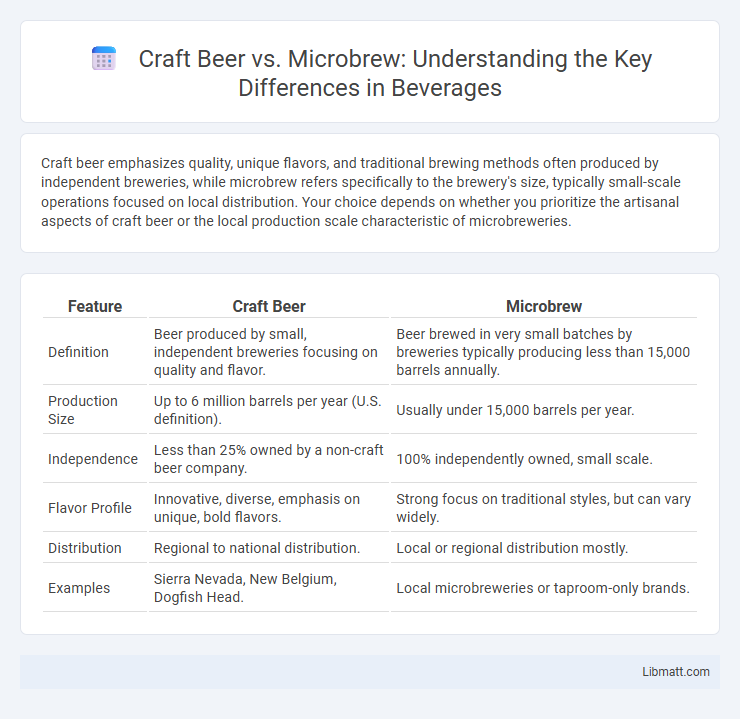Craft beer emphasizes quality, unique flavors, and traditional brewing methods often produced by independent breweries, while microbrew refers specifically to the brewery's size, typically small-scale operations focused on local distribution. Your choice depends on whether you prioritize the artisanal aspects of craft beer or the local production scale characteristic of microbreweries.
Table of Comparison
| Feature | Craft Beer | Microbrew |
|---|---|---|
| Definition | Beer produced by small, independent breweries focusing on quality and flavor. | Beer brewed in very small batches by breweries typically producing less than 15,000 barrels annually. |
| Production Size | Up to 6 million barrels per year (U.S. definition). | Usually under 15,000 barrels per year. |
| Independence | Less than 25% owned by a non-craft beer company. | 100% independently owned, small scale. |
| Flavor Profile | Innovative, diverse, emphasis on unique, bold flavors. | Strong focus on traditional styles, but can vary widely. |
| Distribution | Regional to national distribution. | Local or regional distribution mostly. |
| Examples | Sierra Nevada, New Belgium, Dogfish Head. | Local microbreweries or taproom-only brands. |
Understanding Craft Beer: Definition and Characteristics
Craft beer is defined by small-scale production, independent ownership, and a focus on quality, flavor, and traditional brewing techniques. It emphasizes unique recipes and innovative styles, often highlighting local ingredients and distinctive taste profiles. Unlike mass-produced beers, craft beer offers variety and complexity that appeals to beer enthusiasts seeking authentic and artisanal brews.
What is Microbrew? Key Features Explained
Microbrew refers to beer produced by small, independent breweries that focus on quality, flavor, and traditional brewing methods, typically with an annual production of less than 15,000 barrels. Key features include handcrafted recipes, small-batch production, and an emphasis on creative, bold flavors that distinguish them from mass-produced craft beers. Microbreweries prioritize local ingredients and community engagement, fostering unique beer experiences and innovation within the brewing industry.
Craft Beer vs. Microbrew: Main Differences
Craft beer typically refers to beer produced by independent breweries focusing on quality, flavor, and traditional brewing methods, often emphasizing creativity and small-scale production. Microbrews are a subset of craft beers, defined by their smaller production volume, generally under 15,000 barrels annually, allowing them to maintain local distribution and artisanal techniques. Understanding these distinctions helps you appreciate the scale, scope, and brewing philosophy that differentiate craft beer from microbrew.
The History of Craft Beer and Microbreweries
Craft beer and microbreweries trace their roots back to the 1960s and 1970s when homebrewing gained popularity in the United States, sparking a shift from mass-produced lagers to artisanal beer. The craft beer movement emphasizes unique flavors and quality ingredients, distinguishing itself from traditional macrobreweries, while microbreweries specifically refer to small-scale operations focusing on limited production volumes. This history reflects a broader trend in consumer preference towards local, handcrafted brews that celebrate innovation and authenticity in the brewing process.
Production Scale: Comparing Craft Beer and Microbrew
Craft beer production typically involves small to medium-sized breweries that produce between 15,000 and 6 million barrels annually, emphasizing quality and unique flavors. Microbreweries operate on a smaller scale, producing less than 15,000 barrels per year, often focusing on local distribution and innovative recipes. The primary distinction lies in production scale, with microbreweries being a subset of craft beer makers but defined by their limited output.
Flavor Profiles: Craft Beer Versus Microbrew
Craft beer offers a diverse range of flavor profiles, often characterized by bold, experimental tastes and complex ingredient combinations. Microbrews, typically produced by smaller breweries, emphasize traditional brewing techniques with distinct, locally inspired flavors that highlight freshness and originality. Both craft beer and microbrew prioritize quality ingredients, but craft beer tends to push boundaries in flavor innovation, whereas microbrews focus on consistent, artisanal taste experiences.
Brewing Techniques: Traditional vs. Experimental
Craft beer often emphasizes traditional brewing techniques, focusing on time-honored methods like open fermentation and using classic ingredients to create balanced flavors. Microbrews tend to experiment with innovative processes, incorporating unique yeasts, exotic ingredients, and unconventional fermentation methods to produce bold, distinctive tastes. Your choice between craft beer and microbrew depends on whether you prefer the consistency of tradition or the excitement of experimental brewing.
Local Impact: Community Role of Craft and Microbreweries
Craft breweries and microbreweries significantly boost local economies by creating jobs and sourcing ingredients from nearby farmers, enhancing the agricultural supply chain. These breweries serve as social hubs, fostering community engagement through events, tastings, and collaborations with local businesses, which strengthens neighborhood identity. Their presence contributes to tourism growth and supports local artisans, making them vital pillars in promoting regional culture and economic development.
Market Trends: Popularity of Craft Beer and Microbrew
Craft beer continues to dominate market trends with its diverse flavors and artisanal appeal, attracting consumers seeking unique brewing styles and local authenticity. Microbrews, often synonymous with craft beer but typically produced on a smaller scale, gain traction in niche markets where exclusivity and experimental batches drive popularity. Your preference for craft beer supports a dynamic industry that thrives on innovation and community engagement, fueling steady growth in the global beverage market.
Choosing Your Brew: Factors to Consider
When choosing between craft beer and microbrew, consider the scale of production and flavor variety, as craft beers often feature bold, innovative taste profiles while microbrews emphasize local, small-batch quality. Assess brand reputation and ingredient sourcing, with craft breweries typically using unique, high-quality ingredients to create distinct experiences. Pricing and availability also play key roles, as microbrews may be limited to regional markets, whereas craft beers often have wider distribution channels.
Craft beer vs microbrew Infographic

 libmatt.com
libmatt.com